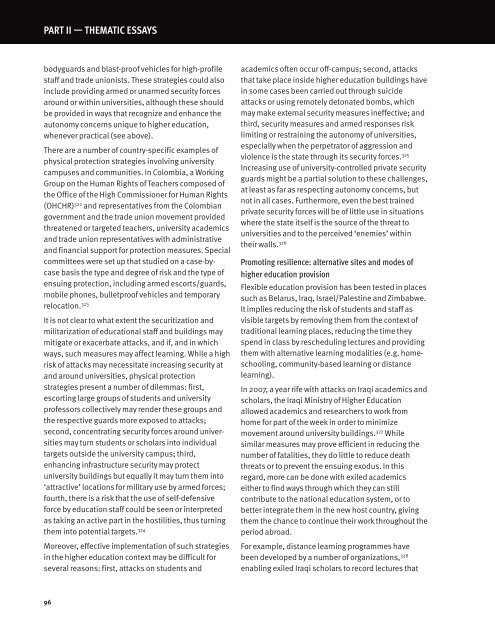Create successful ePaper yourself
Turn your PDF publications into a flip-book with our unique Google optimized e-Paper software.
PART II — THeMATIC eSSAYS<br />
bodyguards and blast-proof vehicles for high-profile<br />
staff and trade unionists. These strategies could also<br />
include providing armed or unarmed security forces<br />
around or within universities, although these should<br />
be provided in ways that recognize and enhance the<br />
autonomy concerns unique to higher education,<br />
whenever practical (see above).<br />
There are a number of country-specific examples of<br />
physical protection strategies involving university<br />
campuses and communities. In Colombia, a Working<br />
Group on the Human Rights of Teachers composed of<br />
the Office of the High Commissioner for Human Rights<br />
(OHCHR) 322 and representatives from the Colombian<br />
government and the trade union movement provided<br />
threatened or targeted teachers, university academics<br />
and trade union representatives with administrative<br />
and financial support for protection measures. Special<br />
committees were set up that studied on a case-bycase<br />
basis the type and degree of risk and the type of<br />
ensuing protection, including armed escorts/guards,<br />
mobile phones, bulletproof vehicles and temporary<br />
relocation. 323<br />
It is not clear to what extent the securitization and<br />
militarization of educational staff and buildings may<br />
mitigate or exacerbate attacks, and if, and in which<br />
ways, such measures may affect learning. While a high<br />
risk of attacks may necessitate increasing security at<br />
and around universities, physical protection<br />
strategies present a number of dilemmas: first,<br />
escorting large groups of students and university<br />
professors collectively may render these groups and<br />
the respective guards more exposed to attacks;<br />
second, concentrating security forces around universities<br />
may turn students or scholars into individual<br />
targets outside the university campus; third,<br />
enhancing infrastructure security may protect<br />
university buildings but equally it may turn them into<br />
‘attractive’ locations for military use by armed forces;<br />
fourth, there is a risk that the use of self-defensive<br />
force by education staff could be seen or interpreted<br />
as taking an active part in the hostilities, thus turning<br />
them into potential targets. 324<br />
Moreover, effective implementation of such strategies<br />
in the higher education context may be difficult for<br />
several reasons: first, attacks on students and<br />
academics often occur off-campus; second, attacks<br />
that take place inside higher education buildings have<br />
in some cases been carried out through suicide<br />
attacks or using remotely detonated bombs, which<br />
may make external security measures ineffective; and<br />
third, security measures and armed responses risk<br />
limiting or restraining the autonomy of universities,<br />
especially when the perpetrator of aggression and<br />
violence is the state through its security forces. 325<br />
Increasing use of university-controlled private security<br />
guards might be a partial solution to these challenges,<br />
at least as far as respecting autonomy concerns, but<br />
not in all cases. Furthermore, even the best trained<br />
private security forces will be of little use in situations<br />
where the state itself is the source of the threat to<br />
universities and to the perceived ‘enemies’ within<br />
their walls. 326<br />
Promoting resilience: alternative sites and modes of<br />
higher education provision<br />
Flexible education provision has been tested in places<br />
such as Belarus, Iraq, Israel/Palestine and Zimbabwe.<br />
It implies reducing the risk of students and staff as<br />
visible targets by removing them from the context of<br />
traditional learning places, reducing the time they<br />
spend in class by rescheduling lectures and providing<br />
them with alternative learning modalities (e.g. homeschooling,<br />
community-based learning or distance<br />
learning).<br />
In 2007, a year rife with attacks on Iraqi academics and<br />
scholars, the Iraqi Ministry of Higher Education<br />
allowed academics and researchers to work from<br />
home for part of the week in order to minimize<br />
movement around university buildings. 327 While<br />
similar measures may prove efficient in reducing the<br />
number of fatalities, they do little to reduce death<br />
threats or to prevent the ensuing exodus. In this<br />
regard, more can be done with exiled academics<br />
either to find ways through which they can still<br />
contribute to the national education system, or to<br />
better integrate them in the new host country, giving<br />
them the chance to continue their work throughout the<br />
period abroad.<br />
For example, distance learning programmes have<br />
been developed by a number of organizations, 328<br />
enabling exiled Iraqi scholars to record lectures that<br />
96



